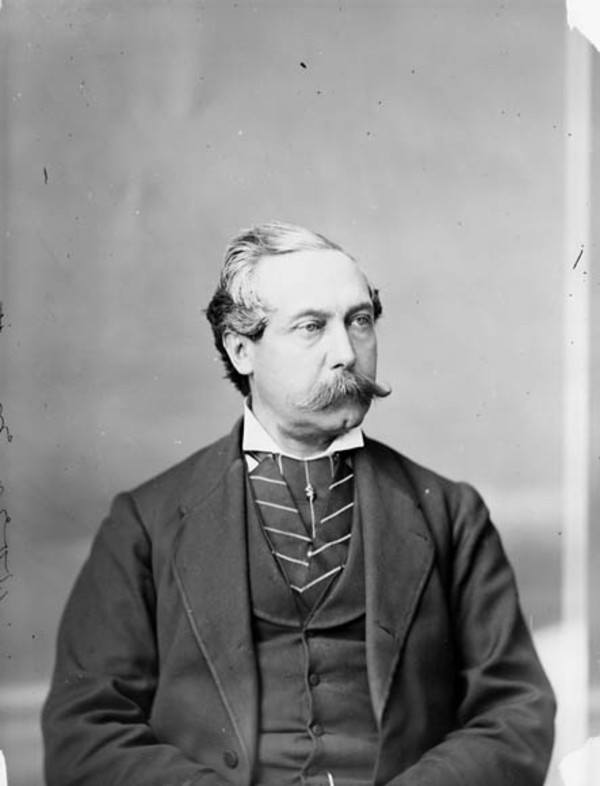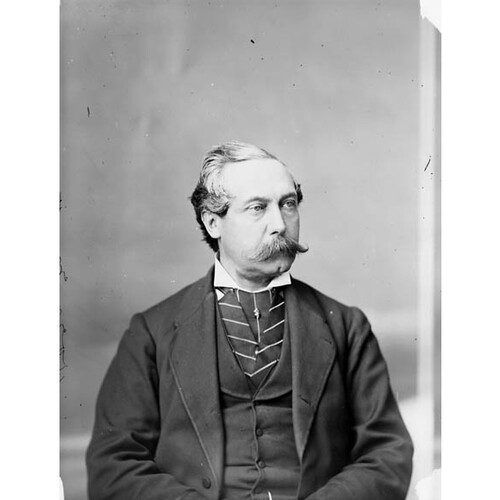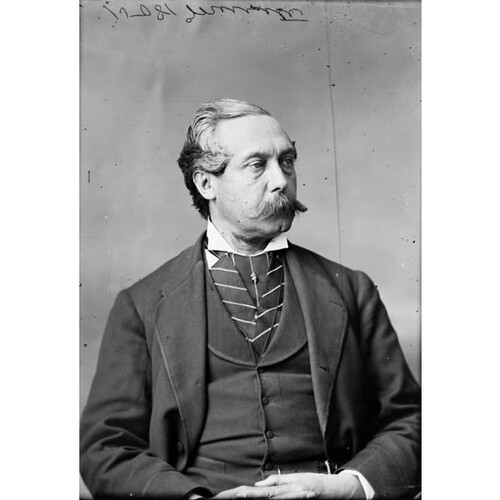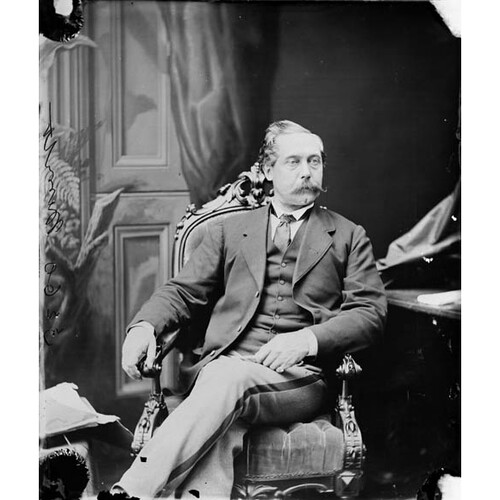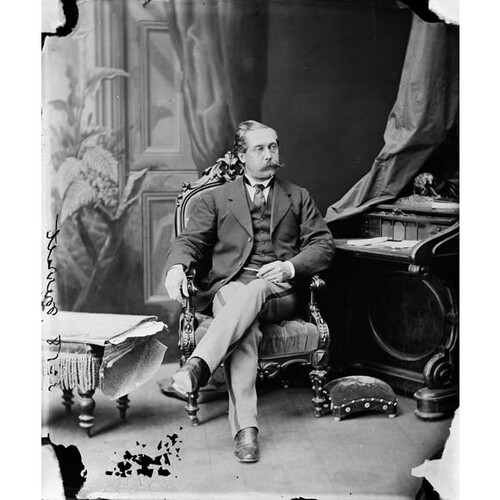As part of the funding agreement between the Dictionary of Canadian Biography and the Canadian Museum of History, we invite readers to take part in a short survey.
MERRITT, THOMAS RODMAN, businessman and politician; b. 17 Oct. 1824 in Mayville, N.Y., youngest son of William Hamilton Merritt* and Catharine Rodman Prendergast; m. 17 Jan. 1853 Mary Benson in St Catharines, Upper Canada; they had no children; d. there 11 Jan. 1906.
Thomas Rodman Merritt was probably born at the home of his maternal grandparents in Mayville. He was educated at Upper Canada College in Toronto in 1837–38 and at Grantham Academy in St Catharines in 1838–39. By November 1839 he had gone to work for Henry Mittleberger in a store at St Catharines. In 1841 and 1842 he was in Montreal, employed for a time by the general wholesale firm of Badenhurst, Turnbill and Company. Having returned to St Catharines, in 1843 he formed a partnership with James Rea Benson, Benson and Merritt, and they opened a general store. Business was evidently good, for in 1845 cash sales totalled about $56,000. The partners soon expanded into flour-milling, acquiring the Lincoln Frame from Samuel Farnsworth and the Welland Stone Mills from Merritt’s father. Merritt managed the mills, both situated on the Welland Canal in St Catharines, and looked after the financial and banking business of the partnership. The milling industry was expanding at this time because of the construction of the second Welland Canal. As a result, in 1847 Benson and Merritt had Louis Shickluna build two schooners, the Shickluna and the Welland, with capacities of 2,400 and 3,000 barrels of flour respectively. Upon the dissolution of the partnership two years later, Merritt got the mills and the ships, Benson the store.
In 1850 Merritt established a shipping line to carry merchandise to Brantford, via the Welland Canal and the Grand River, and to bring wheat back to St Catharines. It was possibly for this line, which lasted until the opening of the Great Western Railway in 1854, that Shickluna built the schooner William Hamilton Merritt and the propeller Brantford. During the Crimean War the price of wheat rose to $2.25 a bushel, but it collapsed immediately afterwards; this drop caused three of the four millers in St Catharines to fail. Merritt, however, had disposed of his wheat in time to save himself. In 1869 he sold his milling and shipping interests to the local firm of Norris and Neelon [see Sylvester Neelon*].
Over the years Merritt pursued other business interests in the Niagara region. With his father and others he had reorganized the Niagara District Bank in 1854 at St Catharines, and he served as vice-president until its merger in 1875 into the Imperial Bank of Canada, of which he also became vice-president and, in 1902, president. In 1860 he had been appointed chairman and managing director of the Canadian board of the Welland Railway, promoted by his father and built between 1853 and 1856. He served in those positions until the line was sold to the Grand Trunk in 1884. In addition, he was a director and president of the Niagara Falls Suspension Bridge Company and president of the Security Loan and Savings Company (1870–1906), the St Catharines Gas Light Company (1870–1905), and the Welland Canal Loan Company (1883–1906).
Merritt undertook responsibilities in the political and educational spheres as well. He served as a town councillor for St Thomas’s Ward in St Catharines from 1857 to 1859. In 1868 the appointment to the Senate of J. R. Benson left the House of Commons seat for Lincoln vacant. Merritt, a Liberal-Conservative, was elected on 13 April and was returned in the general election of 1872. He retired in 1874, declining a unanimous nomination. An Anglican, he took part in the founding of Bishop Ridley College, a boys’ school set up at St Catharines in 1888. He assisted in the purchase of its first piece of property and was made interim president. From 1889 to 1899 he was full president, and he remained on the board until his death in 1906.
Thomas Rodman Merritt had played an important role in the economic life of St Catharines for more than half a century. His house, Rodman Hall, constructed in 1853 near the junction of Twelve Mile Creek and the second Welland Canal, now serves as a public art gallery.
Two photographs of Thomas Rodman Merritt taken around 1873, as well as an engraved portrait, are held by the St Catharines Hist. Museum (St Catharines, Ont.).
AO, F 662, package 50, W. H. Merritt to Penelope Prendergast, 1 Sept. 1838; package 51, Catharine Merritt to William and Penelope Prendergast, 17 Nov. 1839; W. H. Merritt to T. R. Merritt, 5 Nov. 1841; package 52, T. R. Merritt to J. P. Merritt, 13 June, 28 July 1842; package 53, T. R. Merritt to Catharine Merritt, 23 Oct. 1843; T. R. Merritt to Jedediah Prendergast, 2 Jan. 1846. NA, MG 24, E1, 17, T. R. Merritt to W. H. Merritt Jr, 3 Sept. 1843; 21, W. H. Merritt to Jedediah Prendergast, 27 Nov. 1847. Constitutional (St Catharines), 6 Dec. 1866; 14, 21 Jan. 1868. Daily Standard (St Catharines), 11–12, 15 Jan. 1906. Evening Journal (St Catharines), 11 Jan. 1906. St. Catharines Journal, 1844–59. Kim Beattie with A. H. Griffiths, Ridley: the story of a school (2v., St Catharines, 1963). Canadian album (Cochrane and Hopkins), 1: 229. Canadian directory of parl. (Johnson). Canadian men and women of the time (Morgan; 1898). Directories, Lincoln and Welland counties, 1879; Ont., 1871, 1882, 1892/93; St Catharines, 1863/64, 1874–78, 1881/82, 1898, 1904/6. Prominent men of Canada (Adam), 152–55.
Cite This Article
Peter D. A. Warwick, “MERRITT, THOMAS RODMAN,” in Dictionary of Canadian Biography, vol. 13, University of Toronto/Université Laval, 2003–, accessed March 28, 2025, https://www.biographi.ca/en/bio/merritt_thomas_rodman_13E.html.
The citation above shows the format for footnotes and endnotes according to the Chicago manual of style (16th edition). Information to be used in other citation formats:
| Permalink: | https://www.biographi.ca/en/bio/merritt_thomas_rodman_13E.html |
| Author of Article: | Peter D. A. Warwick |
| Title of Article: | MERRITT, THOMAS RODMAN |
| Publication Name: | Dictionary of Canadian Biography, vol. 13 |
| Publisher: | University of Toronto/Université Laval |
| Year of revision: | 1994 |
| Access Date: | March 28, 2025 |


